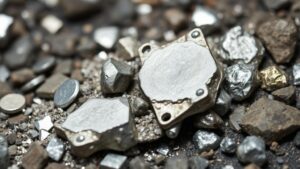How to Recognize Gold-Associated Minerals in Hard Rock Outcroppings
How to Recognize Gold-Associated Minerals in Hard Rock Outcroppings
The process of identifying gold-associated minerals in hard rock formations is crucial for prospectors and geologists alike. These minerals often serve as indicators that precious metals, including gold, may be present in the surrounding area. This article will outline key minerals to look for, provide methods of identification, and discuss real-world applications of such knowledge in geological exploration and mining.
Understanding Gold-Associated Minerals
Gold is seldom found in its pure form within the earth and is typically associated with a variety of other minerals. Recognizing these minerals is essential for successful prospecting. Some common minerals associated with gold include:
- Quartz: Often found in hard rock outcrops, quartz veins can indicate gold deposit locations.
- Pyrhhotite: This iron sulfide mineral can often accompany gold, particularly in intrusive igneous rocks.
- Arsenopyrite: A common indicator of gold deposits, arsenopyrite contains arsenic and iron.
- Galena: While primarily a lead ore, galena can occur alongside gold in various geological settings.
- Iron Oxides: Hematite and limonite are notable iron oxide minerals that may be present in gold-bearing formations.
Key Indicators of Gold Presence
To effectively recognize gold-associated minerals, it is essential to consider specific geological settings and contexts. The following characteristics can help prospectors and geologists pinpoint potential gold locations:
- Geological Setting: Look for outcrops in metamorphic or igneous terrains where hydrothermal activity may have occurred.
- Mineral Assemblage: The presence of certain minerals alongside quartz, such as arsenopyrite or pyrite, often indicates the likelihood of gold.
- Geochemical Indicators: Elevated concentrations of gold, silver, and base metals in soil and rock samples can suggest underlying gold deposits.
Methods of Identifying Gold-Associated Minerals
Several methods can be employed to identify the minerals associated with gold. Some effective techniques include:
- Field Studies: Conducting visual assessments of outcrops, noting mineral color, hardness, and crystal form.
- Petrographic Analysis: Using thin sections of rock samples for microscopic examination can reveal mineral identities.
- Geochemical Testing: Performing assays to determine the concentration of metals in rock samples which can indicate gold presence.
Real-World Applications
The identification of gold-associated minerals has significant implications in the field of mineral exploration and mining. For example, in places like the Mother Lode region in California, the understanding of mineral associations has led to the identification of multimillion-dollar gold deposits. Similarly, the Carlin Trend in Nevada is a prime example of how recognizing specific minerals, such as arsenopyrite, has facilitated successful gold extraction operations.
Conclusion and Actionable Takeaways
Recognizing gold-associated minerals in hard rock outcroppings requires a blend of field knowledge, laboratory analysis, and geological expertise. By familiarizing yourself with key minerals, understanding the broader geological contexts, and employing effective identification methods, you can significantly increase your chances of discovering gold deposits. As a pro tip, always record detailed observations of mineral locations and characteristics, as this data can be invaluable for further exploratory efforts.


